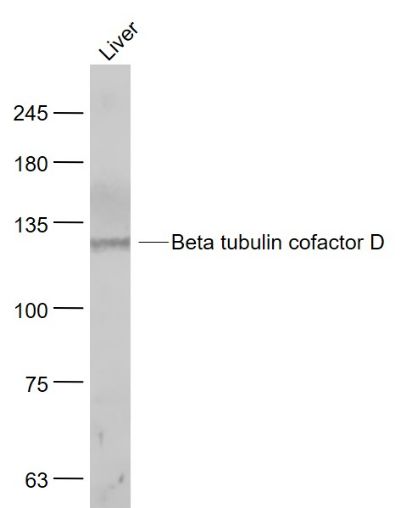Beta tubulin cofactor D Polyclonal Antibody
Purified Rabbit Polyclonal Antibody (Pab)
- SPECIFICATION
- CITATIONS
- PROTOCOLS
- BACKGROUND

Application
| WB, IHC-P, IHC-F, IF, E |
|---|---|
| Primary Accession | Q9BTW9 |
| Reactivity | Rat |
| Host | Rabbit |
| Clonality | Polyclonal |
| Calculated MW | 133 KDa |
| Physical State | Liquid |
| Immunogen | KLH conjugated synthetic peptide derived from human TBCD/Beta tubulin cofactor D |
| Epitope Specificity | 401-500/1192 |
| Isotype | IgG |
| Purity | affinity purified by Protein A |
| Buffer | 0.01M TBS (pH7.4) with 1% BSA, 0.02% Proclin300 and 50% Glycerol. |
| SUBCELLULAR LOCATION | Cell junction, tight junction (Bysimilarity). Lateral cell membrane (By similarity). Cytoplasm (Bysimilarity). Cell junction, adherens junction (By similarity).Note=Localized in cell-cell contacts (By similarity). |
| SIMILARITY | Belongs to the TBCD family.Contains 3 HEAT repeats. |
| SUBUNIT | Found in a complex with at least ARL2, PPP2CB, PPP2R1A,PPP2R2A, PPP2R5E and TBCD. Interacts with PPP2CB. Interacts withARL2 (By similarity). Supercomplex made of cofactors A to E.Cofactors A and D function by capturing and stabilizing tubulin ina quasi-native conformation. Cofactor E binds to the cofactorD-tubulin complex; interaction with cofactor C then causes therelease of tubulin polypeptides that are committed to the nativestate. Interacts with ARL2; interaction is enhanced with theGDP-bound form of ARL2. Does not interact with ARL3, ARL4A andARL4D. Interacts with beta tubulin. |
| Important Note | This product as supplied is intended for research use only, not for use in human, therapeutic or diagnostic applications. |
| Background Descriptions | Tubulin-folding protein; involved in the first step of the tubulin folding pathway. Modulates microtubule dynamics by capturing GTP-bound beta-tubulin (TUBB). Acts as a GTPase-activating protein (GAP) for ARL2. Its ability to interact with beta tubulin is regulated via its interaction with ARL2. Induces microtubule disruption in absence of ARL2. Increases degradation of beta tubulin, when overexpressed in polarized cells. Promotes epithelial cell detachment, a process antagonized by ARL2. Induces tight adherens and tight junctions disassembly at the lateral cell membrane. |
| Gene ID | 6904 |
|---|---|
| Other Names | Tubulin-specific chaperone D, Beta-tubulin cofactor D, tfcD, SSD-1, Tubulin-folding cofactor D, TBCD, KIAA0988, SSD1, TFCD |
| Target/Specificity | Ubiquitously expressed. |
| Dilution | WB=1:500-2000,IHC-P=1:100-500,IHC-F=1:100-500,IF=1:100-500,ELISA=1:5000-10000 |
| Format | 0.01M TBS(pH7.4), 0.09% (W/V) sodium azide and 50% Glyce |
| Storage | Store at -20 ℃ for one year. Avoid repeated freeze/thaw cycles. When reconstituted in sterile pH 7.4 0.01M PBS or diluent of antibody the antibody is stable for at least two weeks at 2-4 ℃. |
| Name | TBCD |
|---|---|
| Synonyms | KIAA0988, SSD1, TFCD |
| Function | Tubulin-folding protein implicated in the first step of the tubulin folding pathway and required for tubulin complex assembly. Involved in the regulation of microtubule polymerization or depolymerization, it modulates microtubule dynamics by capturing GTP- bound beta-tubulin (TUBB). Its ability to interact with beta tubulin is regulated via its interaction with ARL2. Acts as a GTPase-activating protein (GAP) for ARL2. Induces microtubule disruption in absence of ARL2. Increases degradation of beta tubulin, when overexpressed in polarized cells. Promotes epithelial cell detachment, a process antagonized by ARL2. Induces tight adherens and tight junctions disassembly at the lateral cell membrane (PubMed:10722852, PubMed:10831612, PubMed:11847227, PubMed:20740604, PubMed:27666370, PubMed:28158450). Required for correct assembly and maintenance of the mitotic spindle, and proper progression of mitosis (PubMed:27666370). Involved in neuron morphogenesis (PubMed:27666374). |
| Cellular Location | Cell junction, tight junction {ECO:0000250|UniProtKB:Q28205}. Lateral cell membrane {ECO:0000250|UniProtKB:Q28205}. Cytoplasm {ECO:0000250|UniProtKB:Q28205}. Cell junction, adherens junction {ECO:0000250|UniProtKB:Q28205}. Cytoplasm, cytoskeleton, microtubule organizing center, centrosome Note=Localized in cell-cell contacts. {ECO:0000250|UniProtKB:Q28205} |
| Tissue Location | Ubiquitously expressed. |

Thousands of laboratories across the world have published research that depended on the performance of antibodies from Abcepta to advance their research. Check out links to articles that cite our products in major peer-reviewed journals, organized by research category.
info@abcepta.com, and receive a free "I Love Antibodies" mug.
Provided below are standard protocols that you may find useful for product applications.
If you have used an Abcepta product and would like to share how it has performed, please click on the "Submit Review" button and provide the requested information. Our staff will examine and post your review and contact you if needed.
If you have any additional inquiries please email technical services at tech@abcepta.com.













 Foundational characteristics of cancer include proliferation, angiogenesis, migration, evasion of apoptosis, and cellular immortality. Find key markers for these cellular processes and antibodies to detect them.
Foundational characteristics of cancer include proliferation, angiogenesis, migration, evasion of apoptosis, and cellular immortality. Find key markers for these cellular processes and antibodies to detect them. The SUMOplot™ Analysis Program predicts and scores sumoylation sites in your protein. SUMOylation is a post-translational modification involved in various cellular processes, such as nuclear-cytosolic transport, transcriptional regulation, apoptosis, protein stability, response to stress, and progression through the cell cycle.
The SUMOplot™ Analysis Program predicts and scores sumoylation sites in your protein. SUMOylation is a post-translational modification involved in various cellular processes, such as nuclear-cytosolic transport, transcriptional regulation, apoptosis, protein stability, response to stress, and progression through the cell cycle. The Autophagy Receptor Motif Plotter predicts and scores autophagy receptor binding sites in your protein. Identifying proteins connected to this pathway is critical to understanding the role of autophagy in physiological as well as pathological processes such as development, differentiation, neurodegenerative diseases, stress, infection, and cancer.
The Autophagy Receptor Motif Plotter predicts and scores autophagy receptor binding sites in your protein. Identifying proteins connected to this pathway is critical to understanding the role of autophagy in physiological as well as pathological processes such as development, differentiation, neurodegenerative diseases, stress, infection, and cancer.


